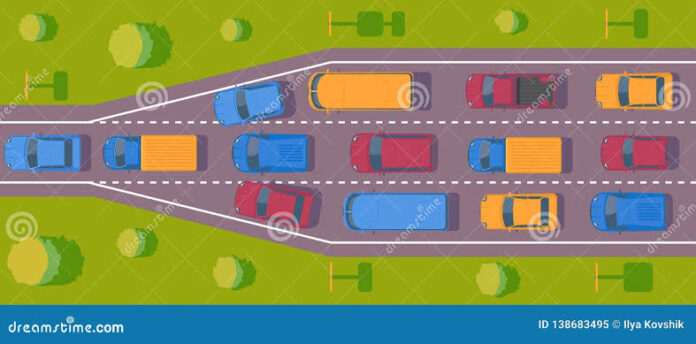Indian roads, particularly in its rapidly urbanizing cities, are increasingly becoming synonymous with gridlock.
What was once an occasional inconvenience has morphed into a daily struggle, impacting productivity, the environment, and the overall quality of life.
Major traffic bottlenecks are not just isolated incidents but rather a symptom of a complex interplay of factors, transforming Indian cities into some of the slowest globally.
The Anatomy of a Bottleneck: Key Contributing Factors
Several critical elements conspire to create the persistent traffic bottlenecks witnessed across India:
Explosive Vehicular Growth vs. Lagging Infrastructure: India’s economic growth has fueled a massive surge in private vehicle ownership. However, road infrastructure, especially within urban centers, has simply not kept pace. Roads are often too narrow, and the rate of new road construction or expansion pales in comparison to the influx of vehicles. This is evident in cities like Bengaluru, where despite metro construction, the sheer volume of vehicles continues to overwhelm the existing network.
Inadequate Public Transportation: A significant reason for the reliance on private vehicles is the insufficient and often overloaded public transport system. In many cities, public buses and trains struggle to meet the growing demand, forcing commuters to opt for personal cars and two-wheelers, further clogging the roads.
Poor Urban Planning and Design Flaws: Haphazard urban development, often without scientific planning, contributes heavily to congestion. Many newly constructed flyovers and underpasses, intended to ease traffic, ironically create new bottlenecks due to faulty geometric designs, sudden narrowing of lanes, and inadequate width at landing points. The conversion of residential areas into commercial spaces without corresponding infrastructure upgrades also adds significant traffic load.
Lack of Traffic Discipline and Enforcement: A pervasive issue on Indian roads is the disregard for traffic laws. Lane indiscipline, illegal parking, wrong-side driving, and a general lack of adherence to road rules exacerbate congestion and lead to frequent minor accidents that trigger cascading traffic jams.
Construction and Maintenance Work: While essential for long-term improvement, ongoing construction activities for new roads, metro lines, or utility upgrades often lead to lane closures and diversions, creating temporary but severe bottlenecks that can last for extended periods.
Uncontrolled Encroachments: Illegal encroachments on roads and footpaths by street vendors and other unauthorized structures further reduce carriageway width, impeding smooth traffic flow.
The Far-Reaching Impact of Congestion
The consequences of these bottlenecks are profound and multi-faceted:
Economic Losses: Hours lost in traffic translate directly into lost productivity for individuals and businesses. This impacts lead times, increases logistics costs, and reduces overall operational efficiency for industries. Studies have estimated significant economic losses due to congestion in major Indian cities.
Environmental Degradation: Stalled vehicles with idling engines contribute heavily to air and noise pollution. This leads to increased respiratory illnesses and a general decline in urban air quality, making cities like Delhi and Kolkata among the most polluted globally.
Health and Well-being: Prolonged exposure to traffic congestion leads to increased stress levels, fatigue, and frustration for commuters. It also contributes to various health issues due to constant exposure to pollutants.
Reduced Quality of Life: The daily grind of navigating traffic jams significantly diminishes the quality of life for urban residents, impacting leisure time, family life, and overall mental well-being.
Increased Fuel Consumption: Vehicles stuck in slow-moving traffic consume more fuel, leading to higher costs for commuters and increased carbon emissions.
Towards a Smoother Ride: Potential Solutions
Addressing India’s traffic bottleneck problem requires a comprehensive and multi-pronged approach:
Strengthening Public Transportation: Investing heavily in expanding and modernizing public transport networks, including increasing the frequency and coverage of buses and metro services, is crucial to encourage a shift away from private vehicles.
Intelligent Traffic Management Systems: Implementing advanced technologies like adaptive traffic signals, real-time GPS tracking of public transport, and integrated traffic management systems can optimize traffic flow and provide commuters with better information.
Improved Urban Planning and Design: Emphasizing holistic urban planning with a focus on mixed-use developments, pedestrian and cycling infrastructure, and scientifically designed road networks is essential to prevent future bottlenecks. Strict enforcement of zoning regulations is also vital.
Enhanced Enforcement of Traffic Laws: Stricter enforcement of traffic rules, including lane discipline, parking regulations, and penalties for violations, can significantly improve traffic flow.
Promoting Sustainable Mobility: Encouraging carpooling, cycling, and walking through dedicated lanes and incentives can reduce the number of vehicles on the road.
Flexible Work Hours and Remote Work: Promoting flexible work timings and remote work options can help spread out peak hour traffic demand.
Congestion Pricing: Exploring congestion pricing models, where drivers are charged for using roads during peak hours, could incentivize the use of public transport or off-peak travel.
Strategic Infrastructure Development: While new roads and flyovers are necessary, they must be designed based on thorough traffic engineering principles to truly alleviate congestion rather than exacerbate it. Land acquisition for road widening and missing links must be expedited.
India’s traffic bottlenecks are a formidable challenge, but with concerted efforts from government agencies, urban planners, and responsible citizens, a smoother, more efficient, and sustainable transportation future is achievable. The shift from a car-centric mindset to one that prioritizes public transport and sustainable mobility is key to unlocking the true potential of India’s urban centers.

